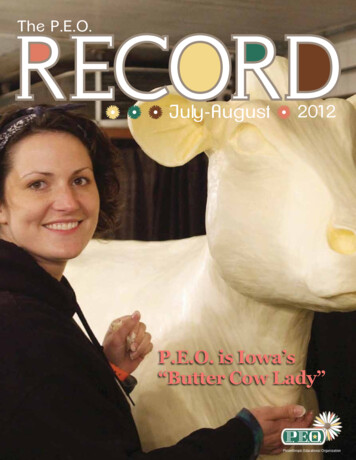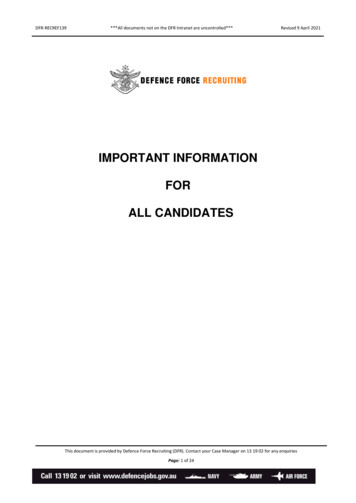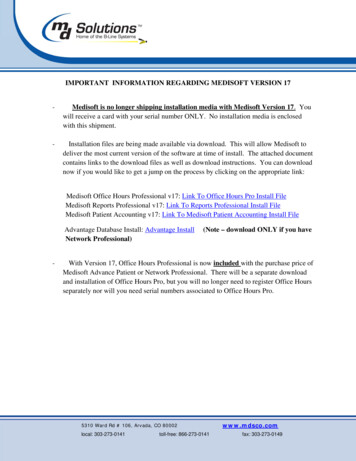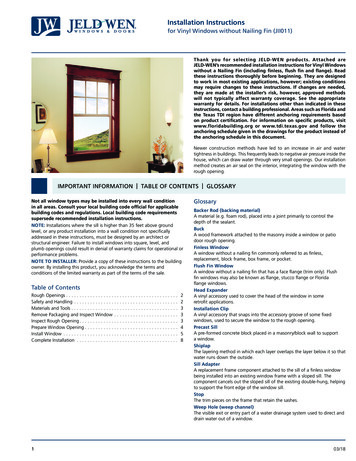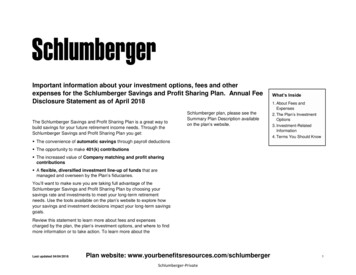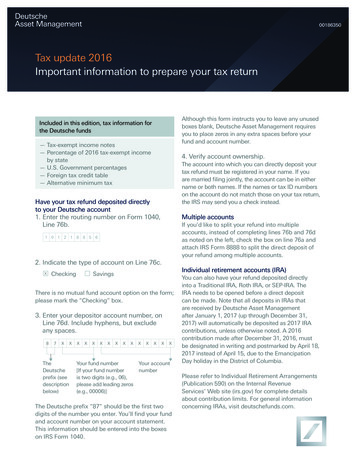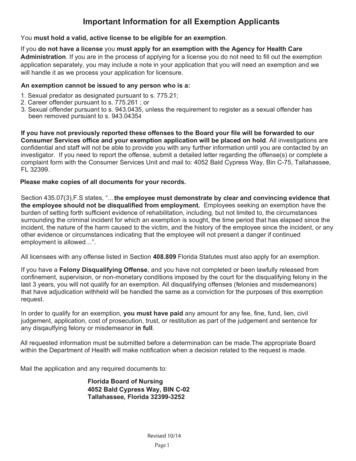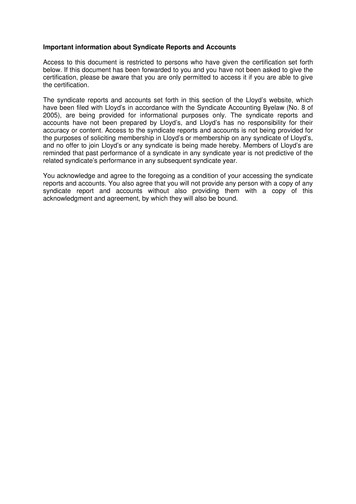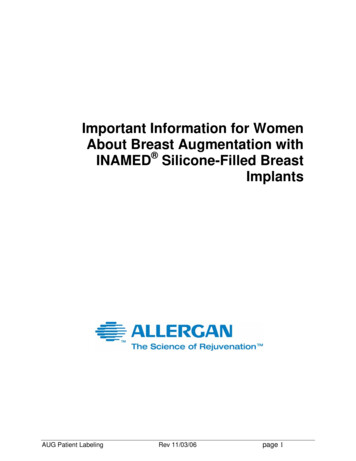
Transcription
Important Information for WomenAbout Breast Augmentation withINAMED Silicone-Filled BreastImplantsAUG Patient LabelingRev 11/03/06page 1
TABLE OF CONTENTSPageGLOSSARY . 31. CONSIDERING SILICONE GEL-FILLED BREAST IMPLANT SURGERY . 91.1 WHAT GIVES THE BREAST ITS SHAPE? . 91.2 WHAT IS A SILICONE GEL-FILLED BREAST IMPLANT? . 101.3 ARE SILICONE GEL-FILLED BREAST IMPLANTS RIGHT FOR YOU? . 101.4 IMPORTANT FACTORS YOU SHOULD CONSIDER IN CHOOSINGSILICONE GEL-FILLED BREAST IMPLANTS . 112. BREAST IMPLANT COMPLICATIONS . 122.1 WHAT ARE THE POTENTIAL COMPLICATIONS? . 132.2 WHAT ARE OTHER REPORTED CONDITIONS? . 183. ALLERGAN* CORE STUDY RESULTS . 203.1 OVERVIEW OF ALLERGAN’S CORE STUDY . 203.2 WHAT WERE THE 4-YEAR FOLLOW-UP RATES? . 203.3 WHAT WERE THE BENEFITS? . 213.4 WHAT WERE THE 4-YEAR COMPLICATION RATES? . 223.5 WHAT WERE THE MAIN REASONS FOR REOPERATION? . 243.6 WHAT WERE THE MAIN REASONS FOR IMPLANT REMOVAL? . 263.7 WHAT WERE OTHER CLINICAL DATA FINDINGS? . 264. SURGICAL CONSIDERATIONS FOR BREAST AUGMENTATION. 284.1 WHAT ARE THE ALTERNATIVES? . 284.2 CHOOSING A SURGEON . 284.3 WHAT ARE OTHER CHOICES AND OPTIONS ASSOCIATED WITH THE SURGERY?284.4 FOLLOW-UP EXAMINATIONS . 315. ADDITIONAL INFORMATION . 325.1 TYPES OF SILICONE GEL-FILLED BREAST IMPLANTS AVAILABLE FROMALLERGAN . 325.2 IF YOU EXPERIENCE A PROBLEM . 335.3 DEVICE TRACKING. 335.4 CONFIDENCE PLUS WARRANTIES . 345.5 HOW TO RECEIVE MORE INFORMATION. 34REFERENCES. 35*Formerly InamedAUG Patient LabelingRev 11/03/06page 2
GLOSSARYAreolaThe pigmented or darker colored area of skin surrounding thenipple of the breast.AsymmetryLack of proportion of shape, size, and/or position between thetwo breasts.Autoimmune diseaseA disease in which the body mounts an “attack” response to itsown tissues or cell types. Normally, the body’s immunemechanism is able to distinguish clearly between what is anormal substance and what is foreign. In autoimmunediseases, this system becomes defective and mounts an attackagainst normal parts of the body, causing tissue injury. Certaindiseases such as rheumatoid arthritis, lupus, and sclerodermaare considered to be autoimmune diseases.AxillaryPertaining to the armpit area.BiocompatibleThe condition of being compatible with living tissues or systemswithout being toxic.BiopsyThe removal and examination of tissues, cells, or fluid from thebody.Body Esteem ScaleA questionnaire which asks about a person’s body image.Breast augmentationA surgical procedure to increase breast size. For thisdocument, it refers to placement of a breast implant. The firsttime a breast implant is placed to increase breast size, it iscalled primary augmentation. All subsequent times the implantis replaced, it is called revision-augmentation.Breast implantAn internal artificial device or implant intended to replace thebreast.Breast massA lump or body in the breast.Breast reconstructionA surgical procedure to replace breast tissue that has beenremoved due to cancer or trauma or that has failed to developproperly due to a severe breast abnormality.AUG Patient LabelingRev 11/03/06page 3
CalcificationProcess of hardening by calcium salts.CapsuleScar tissue which forms around the breast implant. Sometimesthis capsule squeezes the implant, resulting in capsularcontracture (below).Capsular contractureA tightening of the tissue capsule surrounding an implant,resulting in firmness or hardening of the breast and insqueezing of the implant if severe. Capsular contracture isclassified by Baker Grades. Grades III or IV are the mostsevere. Grade III often results in the need for additionalsurgery (reoperation) because of pain and possibly abnormalappearance. Grade IV usually results in the need for additionalsurgery (reoperation) because of pain and unacceptableappearance. Capsular contracture II may also result in theneed for additional surgery. Capsular contracture is a risk forimplant rupture. Below is a description of each Baker Grade. Baker Grade I – Normally soft and natural appearanceBaker Grade II – A little firm, but breast looks normalBaker Grade III – More firm than normal, and looksabnormal (change in shape)Baker Grade IV – Hard, obvious distortion, and tendernesswith painCapsulectomySurgical removal of the scar tissue capsule around the implant.CapsulorrhaphySurgical stitching of a tear in the scar tissue capsule around theimplant.Capsulotomy (closed)An attempt to break the scar tissue capsule around the implantby pressing or pushing on the outside of the breast. Thismethod does not require surgery but is a known risk for ruptureof the implant and is contraindicated.Capsulotomy (open)Surgical incision into the scar tissue capsule around theimplant.Congenital anomalyAn abnormal development in part of the body.Connective tissuedisease/disorder (CTD)A disease, group of diseases, or conditions affecting connectivetissue, such as muscles, ligaments, skin, etc. and/or theimmune system. Connective tissue diseases (“CTDs”) thatinvolve the immune system include autoimmune diseases suchas rheumatoid arthritis, lupus, and scleroderma.ContraindicationA use that is improper and should not be followed. Failure tofollow contraindications identified in the labeling could causeserious harm.ContralateralOpposite side.AUG Patient LabelingRev 11/03/06page 4
Core StudyThe primary clinical study of augmentation, reconstruction, andrevision (revision-augmentation and revision-reconstruction)patients that supported the approval of the premarket approval(PMA) application. Safety and effectiveness data are collectedyearly through 10 years, with the follow-up from years 5through 10 being performed as part of a postapproval CoreStudy.Delayed wound healingDelayed progress in the healing of an opened wound.DisplacementMovement of the implant from the usual or proper place.EpidemiologicalRelating to the science of explaining the relationships of factorsthat determine disease frequency and distribution.Extracapsular ruptureA type of rupture in which the silicone gel is outside of the scartissue capsule surrounding the implant.ExtrusionSkin breakdown with the pressing out of the implant through thesurgical wound or skin.FibromyalgiaA disorder characterized by chronic pain in the muscles andsoft tissues surrounding joints, with tenderness at specific sitesin the body. It is often accompanied by fatigue.Fibrous tissuesConnective tissues composed mostly of fibers.GranulomaA lump or mass made of inflammatory cells surrounding aforeign substance due to longstanding inflammation.HematomaA collection of blood within a space.Hypertrophic scarringAn enlarged scar remaining after the healing of a wound.Immune responseA bodily response to the presence of a foreign substance.InfectionInvasion with microorganisms (for example, bacteria, viruses).An infection usually results in fever, swelling, redness, and/orpain.InflammationThe response of the body to infection or injury that ischaracterized by redness, swelling, warmth, pain, and/or loss offunction.InframammaryBelow the breast.Inframammary foldThe crease at the base of the breast and the chest wall.Inframammary incisionAn incision made in the fold below the breast.AUG Patient LabelingRev 11/03/06page 5
Inpatient surgeryA surgical procedure in which the patient is required to stayovernight in the hospital.Intracapsular ruptureA type of rupture in which the silicone gel remains inside thescar tissue capsule surrounding the implant.LactationThe production and secretion of milk by the breast glandsLow molecular weightsiliconesComponents of silicone of smaller molecular weight that maybleed (leak) out of silicone gel.LymphadenopathyEnlargement of the lymph node(s).MalpositionImplant malposition or displacement is when the implant is notin the correct spot in the breast. This could have been due toincorrect placement of the implant during the surgery or due toshifting of the implant position over time.MRIMagnetic resonance imaging. A radiographic examination thatcurrently has the best ability to detect rupture of silicone gelfilled breast implants.MammaryPertaining to the breast.MammographyA type of X-ray examination of the breasts used for detection ofcancer.MammoplastyPlastic surgery of the breast.MastopexyPlastic surgery to move sagging breasts into a more elevatedposition.Metastatic DiseaseSpreading of cancer cells from the original site to other parts ofthe body.MigrationMovement of silicone materials outside the breast implant.NecrosisDeath of cells or tissues.Outpatient surgeryA surgical procedure in which the patient is not required to stayin the hospital overnight.PalpateTo feel with the hand.PalpabilityThe ability to feel the implant.PectoralisMajor muscle of the chest.PeriareolarAround the darkened or pigmented area surrounding the nippleof the breast.AUG Patient LabelingRev 11/03/06page 6
Plastic surgerySurgery intended for the improvement of appearance of thebody.PostoperativelyAfter surgery.Primary breastaugmentationThe first time a breast implant is placed for the purpose ofbreast augmentation.PtosisBreast sagging that is usually the result of normal aging,pregnancy, or weight loss.ReoperationAn additional surgery after your first breast implantation.Revision-AugmentationRefers to the correction or improvement of a primaryaugmentation. In the context of this document, it refers tosurgical removal and replacement of breast implants that wereplaced originally for primary breast augmentation.RheumatologicalDisease/DisorderA variety of diseases involving connective tissue structures ofthe body, especially the joints and fibrous tissue. Thesediseases are often associated with pain, inflammation, stiffness,and/or limitation of motion of the affected parts. Can includeautoimmune diseases. Fibromyalgia is a rheumatologicaldisorder.Rosenberg Self EsteemScaleA questionnaire which measures overall self esteem.RuptureA tear or hole in the implant shell. Silicone implant rupturesmay be silent or symptomatic. Ruptures can be intracapsularor extracapsular.SalineA solution that is made up of water and a small amount of salt.Scar revisionA surgical procedure to improve the appearance of a scar.SeromaA build-up of the watery portion of the blood in a tissue location.SF-36 ScaleA questionnaire intended to measure physical, mental, andsocial health.Silicone elastomerA type of silicone that has elastic properties similar to rubber.Silent ruptureA breast implant rupture without symptoms and which is notapparent except through appropriate imaging techniques suchas MRI. Most silicone gel-filled breast implant ruptures aresilent (see symptomatic rupture below).AUG Patient LabelingRev 11/03/06page 7
Subglandular placementPlacement of a breast implant underneath and within the breastglands but on top of the chest muscle.Submuscular placementPlacement of a breast implant wholly or partially underneath thechest muscle.Surgical incisionA cut made to body tissue during surgery.SymptomAny perceptible change in the body or its functions thatindicates disease or a phase of a disease.SymptomaticAny evidence or sign of disease or disorder reported by thepatient.Symptomatic RuptureA breast implant rupture that is associated with symptoms(such as lumps, persistent pain, swelling, hardening, or changein implant shape). Some silicone breast implant ruptures aresymptomatic, but most are silent.SystemicPertaining to or affecting the body as a whole.Tennessee Self ConceptScaleA questionnaire that evaluates how the patient sees herself andwhat she does, likes, and feels.AUG Patient LabelingRev 11/03/06page 8
1. CONSIDERING SILICONE GEL-FILLED BREAST IMPLANTSURGERYYou may be considering breast implant surgery to increase the size of your breasts. This isreferred to as breast augmentation. Or you may need revision of a previous breastaugmentation, which is called revision-augmentation. Allergan has prepared this information tohelp you better understand the breast implant procedure and assist you in making an informeddecision about breast augmentation or revision-augmentation surgery. It will help to answersome of the questions you may have about the surgery and about breast implants in general. Itwill also provide you with specific information about the risks and benefits of INAMED SiliconeFilled Breast Implants.This information cannot and should not replace discussing your surgery with your plasticsurgeon. Your decision whether or not to get breast implants should be based on realisticexpectations of the outcome. There is no guarantee that your results will match those of otherwomen. Your results will depend on many individual factors, such as your overall health(including age), chest structure, breast/nipple shape and position, skin texture, healingcapabilities (which may be slowed by radiation and chemotherapy treatment, smoking, alcohol,and various medications), tendency to bleed, prior breast surgery, surgical team’s skill andexperience, type of surgical procedure, and type and size of implant. Make sure you speak withyour surgeon about your expectations of the results, as well as what you can expect regardingthe length of the surgery, your recovery, and any risks and potential complications of thesurgery. Ask questions.As part of your decision, both you and your surgeon will be required to sign Allergan’s consentto surgery form that confirms your understanding of what you have read. This Allergan consentdocument will be provided to you by your surgeon.You should wait at least 1-2 weeks after reviewing and considering this information beforedeciding whether to have primary breast augmentation surgery. In the case of a revisionaugmentation however, your surgeon may find it medically necessary to perform surgerysooner.1.1 WHAT GIVES THE BREAST ITS SHAPE?The breast consists of milk ducts andglands, surrounded by fatty tissue thatprovides its shape and feel. Beneaththe breast is the chest muscle(pectoralis major muscle)AUG Patient LabelingRev 11/03/06page 9
Factors such as pregnancy (when milk glands are temporarily enlarged), rapid weight loss, andthe effects of gravity as you age, combine to stretch the skin, which may cause the breast todroop or sag. However, it is important to realize that implants are used to make the breastlarger. The implants alone may not adequately lift the breast, or correct the effects ofpregnancy, weight loss, or skin stretching. Your surgeon may suggest additional procedures atthe time of the breast augmentation, such as mastopexy, to help achieve improved breast lift.1.2 WHAT IS A SILICONE GEL-FILLED BREAST IMPLANT?A silicone gel-filled breast implant is a sac (implant shell) of silicone elastomer (rubber) filledwith silicone gel. It is surgically implanted either under your breast tissue or under your chestmuscle.1.3 ARE SILICONE GEL-FILLED BREAST IMPLANTS RIGHT FOR YOU?INAMED Silicone-Filled Breast Implants are indicated for females for the following uses(procedures): Breast augmentation for women at least 22 years old. Breast augmentation includesprimary breast augmentation to increase the breast size, as well as revision surgery tocorrect or improve the result of a primary breast augmentation surgery. Breast reconstruction. Breast reconstruction includes primary reconstruction to replacebreast tissue that has been removed due to cancer or trauma or that has failed to developproperly due to a severe breast abnormality. Breast reconstruction also includes revisionsurgery to correct or improve the result of a primary breast reconstruction surgery. (Aseparate patient brochure is available for those women considering breast reconstructionsurgery and should be read prior to reaching a decision to undergo breast reconstruction.)ContraindicationsBreast implant surgery should not be performed in: Women with active infection anywhere in their body.Women with existing cancer or pre-cancer of their breast who have not received adequatetreatment for those conditions.Women who are currently pregnant or nursing.AUG Patient LabelingRev 11/03/06page 10
PrecautionsSafety and effectiveness have not been established in patients with the following: Autoimmune diseases (for example, lupus and scleroderma).A weakened immune system (for example, currently taking drugs that weaken the body’snatural resistance to disease).Conditions that interfere with wound healing and blood clotting.Reduced blood supply to breast tissue.Radiation to the breast following implantation.Clinical diagnosis of depression or other mental health disorders, including body dysmorphicdisorder and eating disorders. Please discuss any history of mental health disorders withyour surgeon prior to surgery. Patients with a diagnosis of depression, or other mentalhealth disorders, should wait until resolution or stabilization of these conditions prior toundergoing breast implantation surgery.1.4 IMPORTANT FACTORS YOU SHOULD CONSIDER IN CHOOSING SILICONEGEL-FILLED IMPLANTS. Breast implants are not lifetime devices, and breast implantation is likely not a one-timesurgery. You will likely need additional unplanned surgeries on your breasts because ofcomplications or unacceptable cosmetic outcomes. These additional surgeries can includeimplant removal with or without replacement, or they can include other surgical procedures.When you have your implants replaced (revision-augmentation), your risk of futurecomplications increases compared to first time (primary) augmentation surgery, so youshould also review the complication rates for revision-augmentation patients to see whatfuture risk rates you may experience. Many of the changes to your breast following implantation are irreversible (cannot beundone). If you later choose to have your implant(s) removed and not replaced, you mayexperience unacceptable dimpling, puckering, wrinkling, or other cosmetic changes of thebreast, which can be permanent. Breast implants may affect your ability to breast feed, either by reducing or eliminating milkproduction. Rupture of a sili
Breast augmentation A surgical procedure to increase breast size. For this document, it refers to placement of a breast implant. The first time a breast implant is placed to increase breast size, it is called primary augmentation. All subsequent times the
